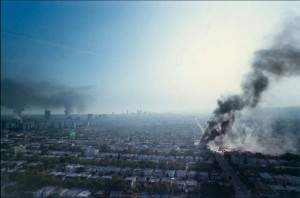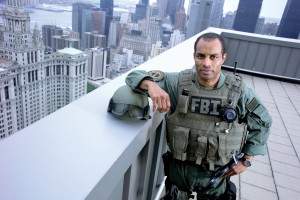Armageddon averted by inches
April 27, 2024 by Thomas Wictor
Sit back, kids, and let your Grandpa Tom tell you about the time we skated to the very edge of Armageddon. It was during the Los Angeles riots of April 29 to May 4, 1992. The reason I’m telling you this is because of the current unrest in Baltimore, Maryland. Before that, it was Ferguson, Missouri. The rioters always claim to be protesting police brutality, but the reality is that they just want to destroy property, steal, and set things on fire.
Prior to the Los Angeles riots—the Rodney King verdict riots is more accurate, as I’ll show in a minute—there were the Watts Riots of August 11-17, 1965.
There was the Detroit Riots of July 23-27, 1967.
And the Baltimore Riots of April 6-14, 1968.
Those are just three, but there’s an axiom about the aftermath: The areas destroyed are never rebuilt. In 1968 Baltimore’s thriving business district was burnt to the ground. The owners said, “To hell with this” and went somewhere else.
It nauseates me to see people looking to government for a solution. Most politicians of all parties are in it strictly for themselves. If there is an ideology, the leadership of one party wants a permanent underclass of sick, angry, ill-educated people with no jobs. They’re a reliable voting bloc. The leadership of the other party has written off that segment of society. All you need to win elections is 50.1 percent. Razor-thin margins don’t bother anybody; victory is victory.
So people burn down their own neighborhoods, and that’s the end of whatever opportunity they had for happy, productive, satisfying lives.
Here’s the Armageddon part.
The United States has a law called the Posse Comitatus Act (Title 18 US Code § 1385), which limits the use of federal military troops for domestic law enforcement. However, in terms of rioting, the Insurrection Act of 1807 (Title 10 US Codes §§ 331 to 335) allows the president to use federal military troops to put down “lawlessness, insurrection, and rebellion.” And that’s what happened in Los Angeles in 1992.
I lived in San Francisco in 1992. On April 29, I called my brother Tim to tell him that I was driving down to conduct some business.
“Be careful,” he said. “They’re burning the city.”
I hadn’t been watching the news, so I didn’t know that rioting had broken out. When I arrived in LA the next morning, there was no traffic, and from the freeway, I could see columns of black smoke everywhere.
At my brother’s house, we watched the LAPD and Los Angeles Sheriff’s Department stand around gawking while people ransacked businesses. There was a clip of a man screaming at rioters, “Why are you looting my store? I’m as black as you are!”
There was no response.
The Koreans didn’t hesitate to defend themselves.
I also remember a story on the front page of the Los Angeles Times. One man stood in front of a store and beat the hell out of an entire mob. He was wearing one sequined glove, like Michael Jackson. The photo showed him simultaneously punching one looter in the face and kicking another in the groin. There were bodies lying on the pavement all around him, along with people sitting and holding their heads. The mob never got past him and eventually gave up.
Governor Pete Wilson requested help from federal troops, among them men of the 1st Marine Division. I’ll tell a funny story about that in a moment.
On the evening of Friday, May 1, Tim and I were watching Night Talk with Dr. David Viscott, a brilliant psychiatrist.
He took a call from a man who claimed to be a member of either the Bloods or the Crips; I can’t remember which street gang. This guy said that federal troops were just another gang. The Bloods and Crips had worked out a truce at a meeting in Las Vegas, and when the troops arrived in Los Angeles, they’d be ambushed.
“We got rockets, grenades, heavy machine guns, land mines—you name it,” the man said, laughing. “We ain’t afraid of them. They got to learn that they can’t just come into our ‘hood and tell us what to do.”
Viscott was horrified and tried to talk the man out of the ambush, but the gangster said honor required that they they fight the troops.
“It’s a matter of respect,” he said.
Well, the very next day, the press began reporting that all the rioting was over. The news anchors seemed almost hysterical. I went outside—worried sick—and I saw a Sikorsky MH-53J Pave Low fly past my house.
This helicopter is designed to “perform low-level, long-range, undetected penetration into denied areas, day or night, in adverse weather, for infiltration, exfiltration and resupply of special operations forces.” It has armor plate and three machine guns: combinations of the .50-caliber M2 and the M134 Minigun. Here’s what Los Angeles gangsters almost brought down on their heads.
That same day, I read in Time magazine that the US Marshals Special Operations Group was in Los Angeles, along with Special Response Teams (SRTs) from the Bureau of Prisons; the Federal Protective Service; the Border Patrol; the Bureau of Alcohol, Tobacco, and Firearms; and the Drug Enforcement Agency. Time also reported that riots were breaking out all over the country.
Prior to May 2, politicians such as Maxine Waters (D-CA) minimized the actions of the looters and arsonists by saying that they had legitimate grievances. After May 2 nobody was talking like that. The thousands of pieholes on TV began speaking in one voice: The rioting had stopped! What happened was that the feds let Ms. Waters and her ilk know that all hell was about to break loose.
Rioting is allowed up to a certain point. Then the hammer comes down. If people want to burn their own neighborhoods and then sit in the cinders, the feds won’t intervene. But if gangsters start down the road to nationwide insurrection, the feds will load their miniguns and put a stop to it.
And guess what? Everything that happened in 1992 came before the Patriot Act. Now, the following government agencies have what are essentially special-operations units.
the Department of Education
the Postal Inspection Service
the Department of Health and Human Services
the Department of Agriculture
the Department of Labor
the Department of Veterans Affairs
the Bureau of Land Management
the Bureau of Indian Affairs
the Environmental Protection Agency
the Railroad Retirement Board
the Tennessee Valley Authority
the Office of Personnel Management
the Consumer Product Safety Commission
If you burn down your own city, nobody will stop you or help you rebuild. If you threaten the stability of the nation, you’ll be killed. I therefore recommend a different approach.
And now the funny story from the Los Angeles riots, which is almost certainly an urban legend, dammit.
US Marines went out with the LAPD on patrol. In one case, the marines and the LAPD had to serve an arrest warrant on a gangster. The cops and marines surrounded the house, and a police officer decided to move into a different position.
“Cover me,” he said to the marines.
In the LAPD, to cover someone means to point your gun in the direction of the danger and be ready if someone makes a threatening move. In the US Marines, to cover someone means to open fire at the enemy while your comrade moves.
The marines shot over 200 rounds into the house.
“Cease fire!” the cops screamed.
As the last echo of the shooting died out, a voice came from the house.
“Okay, that’s it. I give up. You win.”
No matter how tough you think you are, someday you’ll run into someone tougher. It’s another axiom. Think about that the next time you decide to burn down a city.
This article viewed 502 times.




